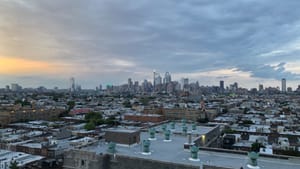Stay in the Loop
BSR publishes on a weekly schedule, with an email newsletter every Wednesday and Thursday morning. There’s no paywall, and subscribing is always free.
Kids are the future, not the enemy
It’s their city, too: Philly’s young people deserve to take up space

The news over Memorial Day weekend was depressingly familiar: according to media reports, a crowd of kids estimated between 200 to 500 gathered at Penn’s Landing. The police dispersed them into nearby residential neighborhoods while the local news, in an increasingly click-focused broadcast environment, beat the fearmongering drum of “mobs” in the street. This echoed news about hundreds of teens converging on the Fashion District in April. In a pandemic-scarred world, teenagers coming into town on a warm spring evening has become a sign of the apocalypse on network TV.
But a few hundred kids is a small gathering for the city. The fireworks on the 4th of July attract hundreds of thousands, and the Philadelphia Police Department used to be admired across the country for crowd-control techniques. But the city has been at war with its children for decades. Love Park was world-famous in skateboarding until the city tore it down for a design specifically hostile to skaters. Skaters in the 1980s and 1990s were mostly white, so the city has been pretty equal opportunity anti-teen for decades, but it is particularly hostile to Black kids.
An ally in City Council
Adorable tots do not turn into tax-paying worker bees by magic. As teens, they have needs: food and shelter, but also safe spaces to gather and learn how to regulate their own social behavior as they grow, and we are shutting them out of those spaces. City Councilmember Isaiah Thomas has a reputation for his focus on youth, so I sat down with his director of communications, Max Weisman, to find out what the city is going to do about it.
Weisman said that we have to change the messaging. Take skateboarding: the “nuisance behavior of yesteryear” has become an Olympic sport. No one is likely to make hanging out in town an Olympic sport (if they did, I’d have had a medal in it) but I get the point: one person’s nuisance is another person’s perfectly valid good time.
For many of us, good times were on hold the past three years, but it’s been harder for kids. “As adults we are still regaining our social balance,” Weisman said, “but we are expecting our young people to do that when they never learned how. We just put them in their bedrooms with a computer for two years and expected it to be the same, but it’s not.”
The city needs to give kids the tools to rebuild their social skills, and to have something to do, but there are few places where teens can go to mix with their peers. Thomas’s basketball camp in August serves kids age six to 16. It now offers yoga classes and collaborates with Mural Arts in what they call a “meaningful middle” between arts and crafts and murals. They offer dance and STEM activities. Not all the kids who showed up actually liked basketball, Weisman said, so leaders asked the kids what they wanted to do.
Thomas’s office also promotes video gaming, and they are working with the schools to create an afterschool program or league. Leagues offer competitions for prize money or scholarships, and we are the only county in the region that doesn’t have one. But it’s not all fun and games: Thomas’s office has an active Instagram account with job listings too.
A night out for teens?
Organized activities are fine, but teens also need unstructured time and, at present, there are few places for them to go at night that are safe and free or cheap. Weisman said he could count them on one hand, but he put in a call to Department of Commerce’s nighttime economy director, Raheem Manning, who has a plan. Teens Night Out would set aside one evening per month, like First Friday, when venues across the city would offer attractions specifically for teens. Grants would subsidize the use of the venues, and Manning envisions local artists taking to the stages.
The program would run in partnership with City Council (Thomas’s office is on board), and also Children and Family Services and the Office of Violence Prevention. Manning says, “With Teens Night Out, we are inviting them to decide, do they like the neighborhood options and opportunities or do they want to go downtown? Or do they want to go to South Street or Penn’s Landing?”
It’s a two-step goal: giving teens experiences tailored to their needs now, which will give them the skills to navigate the nightlife economy as they grow older. I am willing to give the organizers their ulterior motive if it provides a diverse array of places where teens actually want to go. But when we spoke, it was still in the proposal phase, though Manning had high hopes for an August rollout.
Kids need a little chaos
Sometimes, chaos is part of what teens are. Thomas’s office has gone on record supporting a park for the ATVs that plague North Broad Street. Weisman says they want it close enough to Center City that it will attract the riders, but not in a high-density area that creates a nuisance for the residents.
But still, when I asked about Penn’s Landing, Weisman hedged their bets. “Young people gathering is not inherently criminal, and we need to stop treating it that way,” he said. But for that to change, we need “police directives, through conversations with the mayor and the executive team.” City Council is happy to hold a hearing, but “that won’t change anything.”
Their solution would be to figure out where kids want to congregate and use cameras to keep an eye on things, taking police out of the mix entirely. I agree with the notion that we figure out where they want to congregate, and let them. But cameras would seem an unworkable solution. On Roosevelt Boulevard, the camera snaps a pic of a license plate and sends the owner a ticket. It is intrusive to spy on kids when they are out for a bit of innocent (if raucous) fun, and the reality is that cameras can’t protect them if something goes wrong.
Teenagers are people, too
The first, most important step to solving this issue is to stop thinking about our shared public spaces as tourist destinations that have to be protected from the locals. Of course, tourists are welcome—they spend money! But Philly is not Disney World. People live here, and they are entitled to use those spaces even if they are young and don’t have $300 to pay for a hotel room.
The second step is to recognize that teenagers are people. So let them come. And the city has a playbook for this, including bag checks at the entrances. Put in metal detectors. Meet them where you find them, try to make it safe for them, and send them home at curfew. We know how to do this for everybody else; we can do it for our kids as well.
To our shame, Philadelphia is the poorest large city in the country. We are pretty good at attracting empty nesters and young New Yorkers looking for cheaper real estate. But we chase away families who can afford to move once their kids hit their teen years, because the city, so full of things to do for some of us, is a hostile wasteland for the youngsters. If we want to be a vibrant, prosperous city, we have to stop treating our future as the enemy.
Sign up for our newsletter
All of the week's new articles, all in one place. Sign up for the free weekly BSR newsletters, and don't miss a conversation.
 Camille Bacon-Smith
Camille Bacon-Smith